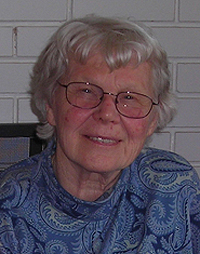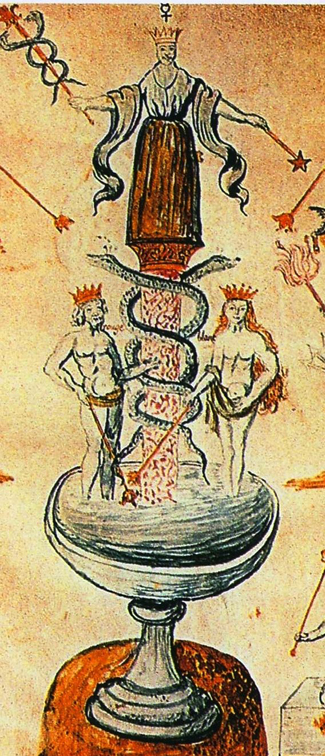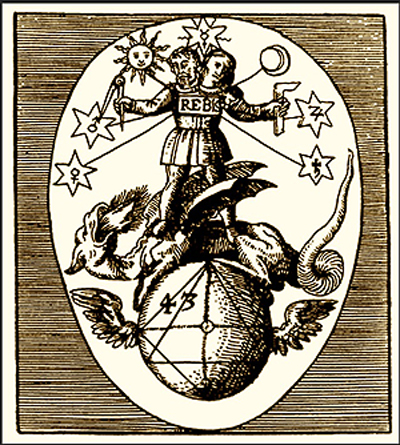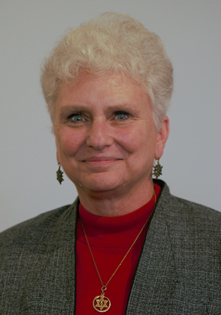Consciousness after Death Kendra Smith
Printed in the Winter 2019 issue of Quest magazine.
Citation: Smith, Kendra, "Consciousness after Death" Quest 107:1, pg 14-17
By Kendra Smith
 Years ago, when I was around forty, I was startled to see and converse with persons who had died. Other experiences followed. This sort of thing was taboo in my academic milieu and in a family studded with scientists (four physicists, one a Nobel Prize winner). Only lately, after a friend urged me to come out with these stories, which many people regard as deluded and weird, have I begun talking freely about these experiences.
Years ago, when I was around forty, I was startled to see and converse with persons who had died. Other experiences followed. This sort of thing was taboo in my academic milieu and in a family studded with scientists (four physicists, one a Nobel Prize winner). Only lately, after a friend urged me to come out with these stories, which many people regard as deluded and weird, have I begun talking freely about these experiences.
Remembering some brief contacts with Theosophy, I called an acquaintance, Nelda Samarel, at the Krotona Institute of Theosophy in Ojai, California. I wondered what the position of Theosophy was on consciousness after death; did Theosophy accept it? She said yes, and she was interested in the content of my communications from the other side.
I had six such experiences. The first three were with strangers, the next three with family members who had passed on. With two of the three strangers, I was able to learn that the persons had actually existed, and I learned something of their life stories.
In this piece, I will relate one of the exchanges with a stranger and a brief conversation with my skeptical philosopher father after his death; then I will discuss some of the questions raised in my mind: What is mind and what are its limits? What is real, what is true? Why do some of us have these experiences while others don’t? One question I will answer immediately: do these experiences have spiritual import? They do not mean that I personally am a better person or more integrated than most, but I believe that they may suggest something about spirit or consciousness.
One experience in particular really shook me up. It happened at a five-day meditation retreat led by Larry LeShan, a clinical psychologist. His daily work was as a psychotherapist, often with cancer patients facing mortality. On the side, he experimented with psychic healing, the cultivation of a state of consciousness that facilitates the healing of others. I’d heard Larry talk about his research at a transpersonal psychology conference in Iceland, and I asked to join his experimental group.
There were ten or twelve of us, all Larry’s friends from New York, except for me, from Boston. Everyone looked to be around my age, forty, except for one man with white hair, Max. Larry’s assistant, who introduced us, told me Max was a lawyer from Manhattan. From the time of our introduction before Friday dinner to our goodbye the next Tuesday, Max and I never talked. We did, however, end up sitting next to each other as we meditated. Hour after hour after hour.
It was intensive one-pointed meditation. From Friday evening through Saturday until around 9 p.m., we tried hard to keep our minds steadily on a single object. Then bed. As I lay in bed, I visualized all the persons in our group, saying their names to myself. It’s something I do to help me remember names. It was a very cold February night, and wind blew in my window curtains. I knew I would have to get up and close the window before I settled down to sleep. I began saying the names to myself: Larry, Mickey, Joyce, John, Maria, and so on, until I got to Max. And then I saw a woman between Max and me that I had not seen in the group.
Silently, in my head, I said, “I don’t remember you. You must have been very quiet.”
“I’m Max’s wife,” she said.
She didn’t look exactly solid—she was sort of transparent, but distinct. She and I had a nice little get-acquainted chat, with her doing most of the talking. This was all in my head, silent. She told me that this part of Connecticut was a great place for birders, and she began naming all the different kinds of birds. I’m not a birder, but I was entertained by the names she reeled off. One stuck in my mind—tufted titmouse. We then said goodnight. I closed my window and slept soundly.
Next morning I saw Max as we waited for the breakfast bell, and I thought of telling him that I had dreamed about his wife. But it wasn’t a dream, and I didn’t know if he had a wife. Larry’s assistant told me that Max had had a wife. She had died three months earlier, and Max had been in deep grief, refusing to leave his apartment until he had been persuaded to come to this retreat. This unsettled me, and yet the conversation with Max’s wife had seemed so ordinary and real. I wondered if I was losing my marbles. Larry was a psychotherapist. I asked to speak with him alone. He asked me what Max’s wife looked like.
“A short, dumpy, old woman,” I said, “with short, iron-gray hair.” I couldn’t think of any distinguishing moles or features. Larry laughed. How many women in Manhattan would fit this description? He also laughed at the fact that I’d said to her, “You must have been very quiet.” In life, he said, she was not at all quiet. Larry also mentioned that Max was a member of the Ethical Culture Society. This meant to me that he was a humanist. I have read the Humanist Manifesto, which says there is no consciousness after death. I figured that if Max’s wife had appeared to him, he would have thought he was hallucinating.
Larry added casually that I had just had a mediumistic experience and needn’t worry about it. I breathed a sigh of relief.
The next “mediumistic” experience was with my father, Henry Nelson Wieman, a philosopher who taught his “empirical naturalism” at the University of Chicago. He dismissed anything that could not be tested by scientific method. Any religious philosophy must, in his view, accommodate science.
While my father was still very much alive, I told him about my communication with Max’s wife. He listened to my account with bright-eyed interest and no sign of the contempt I feared. Then he walked away, saying, “Wishful thinking. Wishful thinking.”
I called after him, “Well, you’re eighty-five and I’m forty-five. Chances are you will know before I do. You rap seven times or something.” He laughed.
Six years later my father died, and this conversation came to mind. Nothing happened. Another three months went by. I woke one September morning, just lying in bed in a deliciously relaxed state, not thinking about anything at all, when my father appeared, looking like a shimmery version of the football player he had once been.
Excitedly, in my head, I asked, “What’s it like? What’s it like?”
He groped for words. This was uncharacteristic of a Harvard Ph.D. who had written many books and lectured his whole life. Slowly and carefully he then replied, “I cannot will. I can only assess.”
Many hours later I saw my husband, the scholar of religions Huston Smith, and told him about this. Thoughtfully, he said, “That’s what St. Augustine said. After death you cannot effect any material changes. But you can evaluate.”
I am still a bit disturbed when I think about this—as if there is nothing to hold on to. I can’t explain it in terms of anything I know. But neither can I explain or understand the reports I get from physicists about action at a distance, or string theory, or how subatomic stuff is altered by the act of the physicist measuring it. I asked one of my nephews, who is a nuclear physicist, to explain to me the experiment he has been conducting for years.
“If you don’t know mathematics,” he said, “you can’t understand physics.”
I don’t know mathematics, so that lets me off the hook so far as physics goes. I can abandon trying to understand it. But these experiences of mine? I can’t abandon an attempt to understand them. I don’t know of any key to understanding them the way mathematics is the key to physics.
The teasing, teasing questions! I began to think about studies: how our collective view of what is true and real has been changed by culture; how it is influenced by language, by studies of intelligence and intuition.
Studies of the human brain began in a small way around the time I was born, with the work of neurosurgeon Wilder Penfield. Now studies of consciousness are burgeoning. There are a few undergraduate courses on the subject, and there are professional journals.
We used to assume that our human brains, while not omniscient, were an accurate mirror of objective reality. Now it is believed that our brains are not so much like mirrors as like a waffle iron. A waffle looks the way it does because of the way a waffle iron is shaped. What we see as reality depends on the shape of our waffle-iron minds. Our waffle-iron brains, yours and mine, are similar enough for us to have enough shared meaning for us to have discussions. And they differ enough for us to have differing views.
Studies of animal intelligence brought home to us how our perceptual organs frame and limit what we see and sense. We don’t see what an eagle sees; we don’t know the rich world of smells lived by a dog. But our human perceptual organs, yours and mine—eyes, ears, and so forth— are quite similar. We can agree on what is blue and on what is softer or harder. In that way, our waffle-iron brains are alike.
Culture shapes our waffle-iron brains. Different cultures shape them differently, influencing what we are open to believing and thinking. In cultures where people believe in consciousness after death—in Finland and among the Australian aborigines, for example—reports of experiences like mine are far more common than in the U.S.
Our understanding of intelligence has changed greatly in my lifetime. In the early 1920s, a scientist named Terman selected a bunch of kids with very high IQs. It was then thought that having a high IQ was like being endowed with a fortune in gold. Terman’s kids were followed throughout their lifetimes. On average Terman’s high-IQ people did quite well in life, but none in the group turned out to be Mozarts or Einsteins or history makers.
The conclusion was that creativity and intuition needed to be better understood. So far as I know, they are still mysterious. People who have bursts of creativity report that it feels quite unlike ordinary thinking. It seems to come out of the blue, or it is as if something is flowing into and through one. Einstein is said to have had an intuitive flash—things falling into place in a new way—that led to relativity theory. To quote him: “The intuitive mind is a sacred gift, and the rational mind is its servant. We have created a society that honors the servant and has forgotten the gift.”
There seem to be inborn differences—different types of waffle-iron brains. C.G. Jung described the differences in terms of four types: thinking, feeling, sensation, and intuition. They are not differences in intelligence, but in what we notice and how we process input. I am an N, or intuition type. Does intuition have anything to do with my conversation with Max’s wife? I don’t know.
Language, too, influences how one understands the world. Language shapes the waffle-iron brain. Not every subtle insight can be translated from one language to another. Let me give one example that has some relevance to the topic. On my wall, I have some Japanese calligraphy painted by a Zen monk. My husband and I listened in as two scholars, one Japanese and one German, discussed how to translate the characters into English. Both of them were fluent in English, German, and Japanese. The first three characters were easy: “Heaven and earth”—meaning everything—have . . . Everything has . . .” Here they paused, stumped. The last character, they agreed, could not be expressed in English but might be translated, although imperfectly, into German. The best approximation in English was “Everything has sentience,” but, they insisted, sentience is misleading. For us English speakers, dead and alive are opposites. The Japanese word the scholars were working to translate also implies something like relationships and affection. (The two scholars agreed that the German word Gefühl, feeling, was a close approximation.) The Zen Buddhist insight is a universe that is not impersonal, not devoid of feeling or caring or intelligence, nor yet is it some deity outside of creation. Imagine, if you can, how it would be if that permeated your worldview. Basic trust!
Individual influences affect our waffle-iron brains, accounting for the way we individuals see things differently. Children in the same family don’t even have the same experience of their parents. In my family, my older siblings remember a mother who was strict but lots of fun. I never knew a mother who was healthy and free of pain. Strict she was, but not at all fun. I was afraid of her. Siblings influence too. All siblings say or do hurtful things. I am so nervous speaking to groups because, I think, the most scathing thing hissed by my siblings was, “You’re showing off! You are just trying to get attention!”
For most of my life, any interest or belief in consciousness after death was regarded as disgraceful, just a cut above child pornography in respectability. Researchers in these subjects were shunned by their colleagues. Although it was more accepted in the U.K., in the U.S. it used to be the consensual conviction that anyone who was rational and understood science would scoff at the idea of the survival of any consciousness after the heartbeat quits. William James, in the early twentieth century, was an exception: he was interested in mediums and reports of communication with the dead. But when his collected works were published after his death, this part of his research was omitted. It was an embarrassment to what was then the scientific community.
Here is a quote from James: “Our normal consciousness, our rational consciousness as we call it, is but one special kind of consciousness, whilst all about it, parted from it by the filmiest screens, there lie potential forms of consciousness entirely different.”
Creeping into our culture is an increasing openness. In this century, a group of scientists and philosophers met annually for a few years at California’s Esalen Institute to discuss consciousness after death. Henry Stapp, one of our most respected theoretical physicists, was in the group. I don’t know what went on, but I’m guessing that they concluded there is no way to prove either the truth or the falsity of consciousness after death, or any way to explain it. The group disbanded.
What about the waffle-iron brains of those of us who see and hear people who have died? I think of four possible predisposing factors. One, a growing acceptance in our culture. Two, being an intuitive type. Three, meditation practice. Most of my experiences occurred during or soon after a meditation retreat. Four, the early death of one’s mother. It has been found that both ESP (extrasensory perception) and mediumistic experiences—I lump the two together—seem to happen more often to persons whose mothers died when they were young. I was seven when I lost mine.
I may have had a visitation from my mother when I was eleven and deeply unhappy, but I didn’t believe in such things then. I knew my father’s conviction that bodily death is the end. I attended some of his lectures and debates, and I also proofread his manuscripts, so I knew his thought pretty well. I didn’t begin to doubt his authority until I was in my teens.
Some scientists studying consciousness say we seem to be no closer to understanding it than ever, that it is a receding horizon. The larger the island of knowledge, the longer the shoreline of what is unknown.
Now the really big questions. I think of what Zen Buddhists call Big Mind. It’s a mistake to think that each of us possesses a piece of Big Mind; we exist in Big Mind as a fish lives in water.
Is consciousness fundamental? Is consciousness primary and matter secondary? Is it the same as spirit, or the spiritual?
These questions have personal meaning for me. My feeling about death is different now. I think of my friendly death. Not only will I be released from a body that gives me more pain and less pleasure, but I will not be wholly cut off from those I love most. I will be aware and somewhat connected. And—maybe—curiosity and learning will continue. That would be nice.
Because Max’s wife appeared to me, a stranger, Max could accept it as real when Larry told him of her appearance to me. Did his wife know of his grief and figure out how to convince him that her death was not annihilation or the end of their relationship? I think she did know, and she reached out to comfort him in the only way she knew. The import for me is that the cosmology expressed in the Zen calligraphy is right. The universe is not devoid of feeling or caring.
What I feel most powerfully is the vastness of the mystery in which we are born, live, and die.
Kendra Smith, age ninety-five, is a retired psychotherapist living in Berkeley, California. At age fifteen, she was drawn to Buddhism and remains committed to its practice. Her first intensive meditation experiences, along with her husband, Huston Smith, were in Burma and Japan in 1957.




 Gender continues to be discussed from a variety of perspectives: identity, roles, socialization, sexual orientation, stereotypes, feminism, patriarchy, dysphoria, harassment, assault, and so on. As we know from spiritual studies, the soul, or the higher aspect of ourselves, is not gendered, so conversations about gender inevitably revolve around the physical level. Regardless, the dialogue regarding gender issues allows us, and hopefully requires us, to deeply consider our perspectives as well as our societal conditioning.
Gender continues to be discussed from a variety of perspectives: identity, roles, socialization, sexual orientation, stereotypes, feminism, patriarchy, dysphoria, harassment, assault, and so on. As we know from spiritual studies, the soul, or the higher aspect of ourselves, is not gendered, so conversations about gender inevitably revolve around the physical level. Regardless, the dialogue regarding gender issues allows us, and hopefully requires us, to deeply consider our perspectives as well as our societal conditioning.